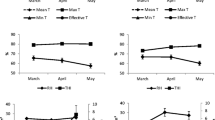Abstract
This study was carried out to examine the impact of several climate variables on the pregnancy rate after cervical artificial insemination (AI) of Rasa Aragonesa ewes. Data were derived from 8,977 inseminations in 76 well-managed flocks performed during the first month of the breeding season (July to October). The following data were recorded for each animal: farm, year, month of AI, parity, lambing–treatment interval, inseminating ram, AI technician, and climatic variables such as mean, maximum and minimum temperature, mean and maximum relative humidity, rainfall, and mean and maximum temperature–humidity index (THI) for each day from day 12 before AI to day 14 post-AI. Means were furthermore calculated for the following periods around AI (day 0): −12 to 0, −2 to 0, AI day, 0 to 2, and 0 to 14. Logistic regression analysis indicated that the likelihood of pregnancy decreased when maximum temperature in the 2 days prior to AI was higher than 30 °C (by a factor of 0.81). Fertility was also lower for primiparous ewes and in multiparous ewes with more than five previous parturitions. Other factors with significant impact on fertility were flock, technician, inseminating ram, and a lambing–AI interval longer than 240 days. It was concluded that the 2 days prior to AI seems to be the period when heat stress had the greatest impact on pregnancy rate in Rasa Aragonesa ewes.
Similar content being viewed by others
References
Alliston CW, Ulberg LC (1961) Early embryonic loss in sheep at ambient temperatures of 70 °F and 90 °F as determined by embryo transfer. J Anim Sci 20:608–613
Anel L, Kaabi M, Abroug B, Alvarez M, Anel E, Boixo JC, de la Fuente LF, Paz P (2005) Factors influencing the success of vaginal and laparoscopic artificial insemination in churra ewes: a field assay. Theriogenology 63:1235–1247
Casu S, Cappai P, Naitona S (1991) Effects of high temperatures on reproduction in small ruminants. Animal Husbandry in Warm Climates no 55 EAAP Publication. pp 103–111
David I, Robert-Granie C, Manfredi E, Lagriffoul G, Bodin L (2008) Environmental and genetic variation factors of artificial insemination success in French dairy sheep. Animal 2:979–986
De Rensis F, Scaramuzzi RJ (2003) Heat stress and seasonal effects on reproduction in the dairy cow—a review. Theriogenology 60:1139–1151
Dutt RH (1963) Critical period for early embryo mortality in ewes exposed to high ambient temperature. J Anim Sci 22:713–719
Dutt RH, Ellington EF, Carlton WW (1959) Fertilization rate and early embryo survival in sheared and unsheared ewes following exposure to elevated air temperature. J Anim Sci 18:1308–1318
Forcada F, Abecia JA, Sierra I (1992) Seasonal changes in oestrous activity and ovulation rate in Rasa Aragonesa ewes maintained at two different body condition levels. Small Rumin Res 8:313–324
Fukui Y, Kohno H, Okabe K, Katsuki S, Yoshizawa M, Togari T, Watanabe H (2010) Factors affecting the fertility of ewes after intrauterine insemination with frozen–thawed semen during the non-breeding season. J Reprod Dev 56:460–466
Garcia-Ispierto I, Lopez-Gatius F, Bech-Sabat G, Santolaria P, Yaniz JL, Nogareda C, de Rensis F, Lopez-Bejar M (2007) Climate factors affecting conception rate of high producing dairy cows in northeastern Spain. Theriogenology 67:1379–1385
Habeeb AA, Marai IFM, Owen JB (1992) Heat stress. In: Philips C, Piggens D (eds) Farm animals and the environment. CAB Int, New York, pp 27–47
Hahn L (1969) Predicted versus measured production differences using summer air conditioning for lactating dairy cows. J Dairy Sci 52:800–802
Hosmer DW, Lemeshow S (1989) Applied logistic regression. Wiley, New York, USA
Jainuden MR, Hafez ESE (1987) Sheep and goats. In: Hafez ESE (ed) Reproduction in farm animals, 5th edn. LEA & Febiger, Philadelphia
Kleemann DO, Walker SK (2005) Fertility in South Australian commercial Merino flocks: relationships between reproductive traits and environmental cues. Theriogenology 63:2416–2433
Marai IFM, El-Darawany AA, Fadiel A, Abdel-Hafez MAM (2007) Physiological traits as affected by heat stress in sheep—a review. Small Rum Res 71:1–12
McDowell D, Hooven N, Cameron K (1979) Effects of climate on performance of Holsteins in first lactation. J Dairy Sci 28:2418–2435
Mendoza MR, Montaldo HH, Sanchez JAB, Ceron JH (2009) Serum progesterone levels in Pelibuey and Suffolk ewes under thermal stress. Vet Mex 40:197–202
Palacin I, Yániz JL, Fantova E, Blasco ME, Quintín-Casorrán FJ, Sevilla-Mur E, Santolaria P (2012) Factors affecting fertility after cervical insemination with cooled semen in meat sheep. Anim Reprod Sci 132:139–144
Santolaria P, Palacin I, Yániz JL (2011) Management factors affecting fertility in sheep. In: Manafi M (ed) Artificial insemination in farm animals. INTECH, Rijeka, Croatia
Shelton M (1964) Relation of environmental temperature during gestation to birth weight and mortality of lamb. J Anim Sci 23(2):360–364
Smith ID (1964) Reproduction in merino sheep in tropical Australia. Aust Vet J 40:156–160
Smith ID, Bell GH, de Chaneet G (1966) Embryonic mortality in merino ewes exposed to high ambient temperatures. Aust Vet J 42:468–470
Thom EC (1959) The discomfort index. Weatherwise 12:57–59
Thwaites CJ (1967) Fleece length and the reactions of sheep to elevated humidity and radiant heating at high ambient temperatures. Res Vet Sci 8:463–466
Thwaites CJ (1969) Embryo mortality in heat stressed ewe-2. Application of hot-room results to field conditions. J Reprod Fertil 19:255–262
Acknowledgments
The authors thank Neil Macowan for assistance with the English translation, the UPRA-Grupo Pastores for their cooperation and help with the flock data collection, and the Spanish Agency of Meteorology (AEMET, Ministry of Agriculture, Food and Environment, Spain) for the facilities offered them during this study. This work was supported by the Spanish MINECO (grant AGL2011-30353-C02-01) and the DGA-FSE (grant A40).
Author information
Authors and Affiliations
Corresponding author
Rights and permissions
About this article
Cite this article
Santolaria, P., Yániz, J., Fantova, E. et al. Climate factors affecting fertility after cervical insemination during the first months of the breeding season in Rasa Aragonesa ewes. Int J Biometeorol 58, 1651–1655 (2014). https://doi.org/10.1007/s00484-013-0770-8
Received:
Revised:
Accepted:
Published:
Issue Date:
DOI: https://doi.org/10.1007/s00484-013-0770-8




